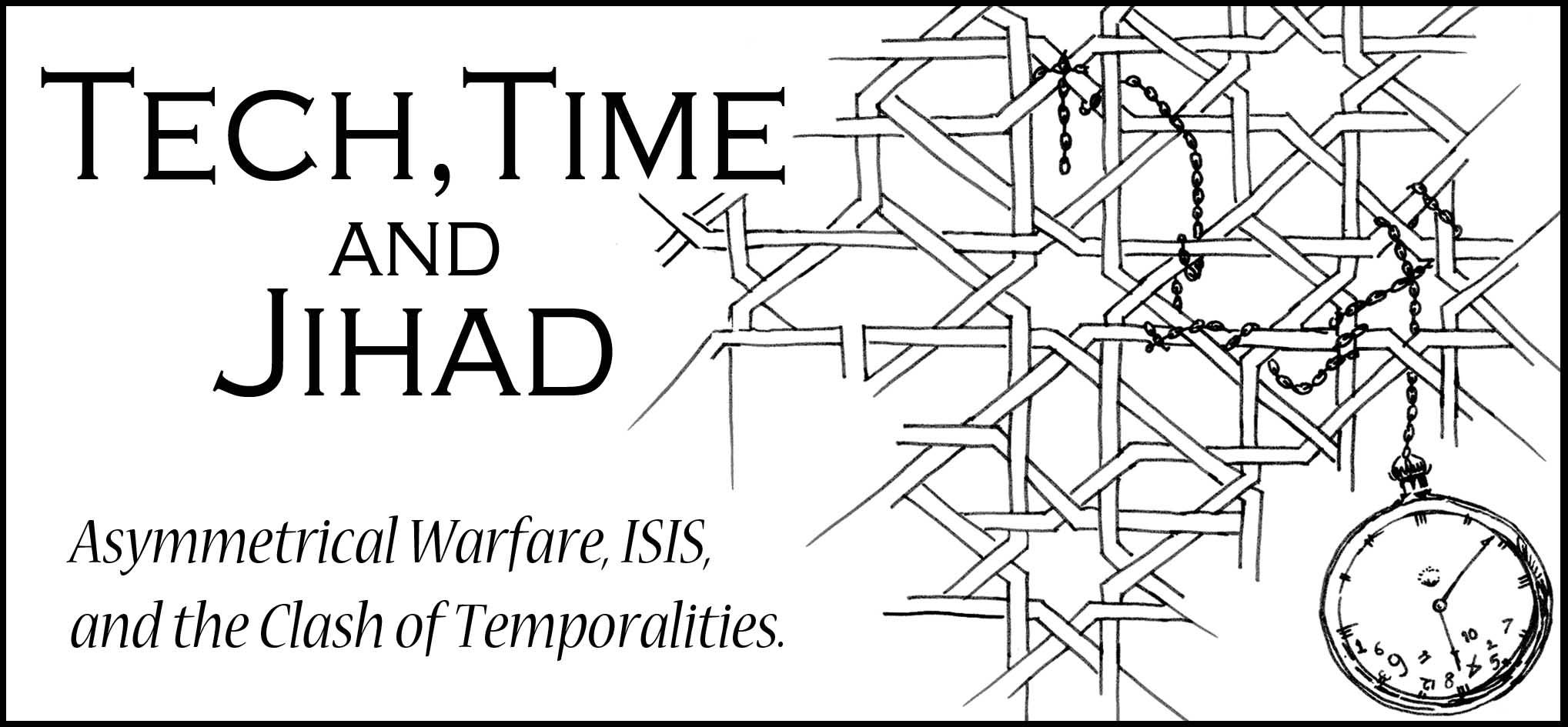Issue 22, spring 2016
https://doi.org/10.70090/RH16TTAJ
On December 28th, 2015, when the Iraqi army felt confident enough of the military situation around Ramadi, the capital of Anbar province, it invited the world’s media to witness the raising of the national flag atop a central administration building. For the Iraqi government, the ejection of ISIS jihadists from Ramadi was a propaganda opportunity too good not to exploit. And valuable vision was on offer: as well as mainstream media coverage, social media buzzed with smartphone footage of the black flag of the jihadists being yanked off and thrown to the dust and the Iraqi 2008-vintage national flag waved triumphantly by a government soldier—before being fixed to the rooftop. It was a proclamation of the return to the old (new) order.
Seven months earlier ISIS had dramatically taken Ramadi under the cover of a sandstorm. The opportunity for the Iraqi army to atone for what was widely seen as a national humiliation could not come quickly enough. The day after, Prime Minister Haider al Abadi landed and addressed the media, with ISIS still defending in pockets around the city and able to shoot small arms fire at his helicopter as he hovered into town. With Iraqi flag in hand Abadi proclaimed: “If 2015 was a year of liberation, 2016 will be the year of great victories, terminating the presence of Daesh (ISIS) in Iraq and Mesopotamia.” He went on to predict: “We are coming to liberate Mosul, which will be the fatal blow to Daesh (ABC News 2015).”
In one sense, and from a Western perspective, there is nothing particularly noteworthy about such statements. They convey the standard political assurances that fighting is going well and will soon be over. With the inevitable toll on human life, it is natural that long wars are undesirable. Whether it reflects the reality or not, politicians must always try to reassure their people that everything possible will be done to ensure a swift closure to fighting. Abadi gave the public a deadline, a timeline wherein victory (of a kind) will come sooner rather than later, and in so doing made his government and his army hostage—not necessarily to fortune—but to the Western conception of time.
In another sense, Abadi’s proclamations reveal something more profound about the nature of asymmetrical warfare between the West and radical Islam more broadly, in which the Iraqi army acts as Western proxy. If we think about the human relationship with time and technology, what we have seen since the rise of radical Islam in the late 1970s is the enacting of an asynchronous war, or a “clash of temporalities”, that corresponds with Samuel Huntington’s thesis of the “clash of civilizations (1993).” It is a clash between a Western and secular conception of time that is rigid and based upon the clock which inexorably speeds faster and faster through technological development, and a Muslim and sacred conception where time belongs to God. The Muslim time is a time where “what is to be” is pre-ordained by Allah, but may be interpreted in a way that is “practical” and “dynamic” enough, as Gerhard Böwering (1997, 65-66) puts it, to ensure that it can incorporate the time and space shrinking technologies of the Internet to produce a form of temporal and mediated jihad that has a potency, a durability and a freedom that the Western relationship with modern industrial time cannot hope to attain.
The West: Clock-time, Capitalism and the Need for Short Wars
Why can’t the West “do” long wars? Well, Abadi’s bombast expressed an essential Western temporal sensibility that emerged with the industrial revolution. Capitalism, industry and modernity itself were made possible by the adoption of clock time, which injected a necessary organizational rhythm into everyday life, supplanting the earlier pre-modern forms of time-reckoning that had endured in Europe for millennia (Thrift 1996). In her Time, Memory, and the Politics of Contingency, Smita Rahman observes that Western “secularism as a political doctrine…carries within it a particular time-image. It articulates a concept of time that became the time of the political—a homogeneous, sequential and linear concept of time, structured by progress… (2014, 106).”
Progress is measured by material abundance and technological innovation, and it is technology in particular that links capitalist modernity and industrialism with warfare. As technology became the basis for problem solving in Western societies, the “problem” of war also became amenable to technological solutions. This logic had been present long before industrialisation, of course. However, as European societies oriented increasingly around scientific discovery, a detached rational efficiency became the guiding aim. The conduct of warfare thus became a problem to be solved by more efficient technologies of war, with efficiency itself being interpreted as doing things faster (in shorter timeframes) through innovation.
The linkages between industry, technology, and war became fully fledged by 1914, when war was fought for the first time on an industrial scale with industrial weapons and with an inflexible industrial timetable that linked the factory to the front. However, human beings were barriers to efficiency in the Western, rational model, so to replace people with technology, as factory owners from the 17th century onward realized, was the best solution to problems of efficiency (Ashworth 1996). Since the 20th century, the prosecution of war has not been different in this respect. It is well known that early innovation in computing, from Charles Babbage in the 1840s to Norbert Weiner a century later, was oriented toward automation. In the US in the 1950s, the military industrial complex gave us cybernetics and the blueprint for the Internet, and in the 21st century, the automation logic that made these possible gave life to the drone.
As noted, it is natural for people to seek to limit the time spent waging war. From a strictly humanist perspective, wars of any duration are tragic and wasteful. However, Western-dominated societies find themselves in a temporal trap that is not connected to a humanist angst, but to a rationalist logic where human conflict on the international scale has to have an increasingly short time frame due to the rationalist culture that drives our relationship with time and the need to use time efficiently in industrial production as well as war. Automated warfare is the inevitable result of this process. Interconnected and interdependent global capitalism can bear, almost on an open-ended timeframe, automated warfare where Western drones bomb distant targets. Contrastingly however, Western rationalist culture cannot bear long endure wars that need boots on the ground, unless they are proxy boots. 21st century war must be increasingly abstracted and automated if it is going to be protracted. The problem is that drone warfare does not work; it doesn’t bring victory but rather stokes the flame of resentment and revenge from the survivors who climb from the rubble (Greenwald 2013).
Islamic Time, Jihadi Times
Time in Islamic thought is viewed “as a series of predetermined events binding divine omnipotence to the certain occurrence of each instant of a person’s life span (Böwering 1997, 58)”. Time belongs to God, and time has no real existence in Islam apart from God. Indeed, Arabic grammar, as Böwering tells us, lacks proper verbs for ‘to be’ and ‘to become’, because all is already fated (60). This may seem like a recipe for political passivity, a theological warrant, so to speak, for nonparticipation in the impiety of worldly affairs, because all is Insha’Allah (if Allah wills it) anyway. Moreover, for much of the 20th century Islam was politically quiescent. However, as Gilles Kepel (2003, 23-43) shows, modern political Islam was a ‘cultural revolution’, one that would lead to the “clash of cultures” and the “clash of temporalities” that are such important aspects of the present conflict.
Tracing its roots in Greek philosophy, Böwering identifies “dynamism” within the concept of time in Islam that expresses potential whereby the omnipotence of divine time can be combined with the practical activity of the individual and group. As he puts it, in Islam: “Eternity belongs to God alone, but God’s creature participates in the present moment (62).” Here we find an interpretive gap between the irreversible destiny of the individual on earth, and the potential freedoms contained in the “immensely practical aspects of Muslim thought” (Böwering 1997, 62).
Interpretive flexibility was presented as doctrinal purity in the writings of Sayyid Qutb, one of the founders of political Islam. Writing at the apex of the secular Arab nationalist movement that threatened to bury Islam as a cultural force, Qutb saw practical political action (an Islamic revolution) as the only way to preserve Islam from the growing depredations of the secular state. Whilst in prison in Egypt Qutb wrote a commentary on the Quran, titled The Shade of the Quran, which he finished just before he was executed on charges of plotting to assassinate Gamal Abdel Nasser. Citing the Quran, Qutb notes that God had made men His “vice-regents”, or representatives on earth. This leads to reflections in a chapter titled “Man in Charge of the Earth” where Qutb writes: “Man is specifically taught and directed to study the world around him, discover its potential and utilize all his environment for his own good and the good of his fellow humans (Qutb, 50). In Qutb’s eyes, Muslims have the duty (through jihad) to use whatever God has provided on the earth, material and technological, to free themselves from the state of barbarism, a status to which they had reverted.
British Prime Minister David Cameron recently described ISIS as a band of “medieval monsters”. Monstrous killers they may be, but the terrorist organization is definitely not medieval. Militant jihadis of every stripe have no hesitation to utilize their technological environment to the fullest extent possible. For example, Osama bin Laden argued that obtaining chemical weapons was a religious duty in the struggle against the West, and ISIS doubtlessly would, if it could, launch drone strikes against New York or Paris or London. The killing and mayhem in the clash of civilizations that we see before us today is essentially the violent expression of an underlying clash of political ideas. Considering how to be successful in the battle of ideas, French philosopher Régis Debray laid stress upon what he termed “the material forms and processes through which [political] ideas were transmitted—the communication networks that enable thought to have social existence (2007, 5)”.
Through expert use of digital media, ISIS has pioneered the methods of giving practical expression to jihadist ideology. Consider the audacity contained in the theological interpretation that gives political Islam such a powerful weapon. Time belongs to Allah who preordains everything, right down to the time and place of one’s death; yet jihadi media networks shrink time and space, displaying a practical control over these dimensions. For example, the idea of the Caliphate was an obscure idea prior to 2015. But with extensive use of media technology to disseminate a radical idea in order to cultivate support for it, ISIS, in a few short months, created the basis whereby the idea actually achieved what is “social existence” in Debray’s phrase.
It was noted earlier that the 1970s emergence of political Islam was a “cultural revolution”, but it was more than that. Evolving in tandem with neoliberal globalization and the information technology revolution, political Islam is also the actualization through media of a set of radical ideas. Therefore, in that respect, political Islam is more than a mélange of groups or sects or shape-shifting alliances—it’s all of these—but it is also a network in the ideological sense, and more importantly a network in the technological sense. The Internet was created to be a distributed communications network, as opposed to a centralised one, a network that would survive attack in time of war. The interactivity of Web 2.0 Internet could have been tailor-made for the political Islam and violent jihad it espouses. James Meek (2015, 6) here gives a good description of what the network means for the survival of a mediated idea:
Western governments have mistaken a super-decentralized network, somewhere between a franchise and an ethos, for an agency with a postal address. (…) It is useful for an ISIS aspirant to have a Raqqa to go to for training, for battle experience, for validation by a set of jihadi peers. But for a mobile terrorist franchise like ISIS or al-Qaida, Raqqa is a concept, not a place. Once Osama bin Laden’s Raqqa was in Sudan. Then it was in southern Afghanistan. It could be in Pakistan, in Somalia, in Yemen, in northern Nigeria, in the Russian Caucasus, or all these places at once.
Margaret Thatcher once argued that in order to defeat terrorism, the “oxygen of publicity” must be cut off. Freedom of speech complications aside, in pre-Internet 1985 this made a kind of strategic sense. However, political Islam has an inexhaustible supply of “oxygen” of its own produced by distributed networks of communication that cannot easily be shut off. Like the God they seek to represent, the jihadists have their own control over space through these networks, and they have their own control over time in that the time-pressure felt by the West to “end it quickly” which does not exist with the adoption of the Islamic time perspective.
Conclusions
In ways that Sayyid Qutb and others of his generation could not have imagined, the taking on of the practical role of vice-regent for God by present-day jihadists has created a powerful weapon that the West is ill equipped to deal with. We have seen that the West approaches war as a problem to be solved through technological means. In the network society context, Evgeny Morozov has called this drive “solutionism”, where computer efficiency and automation are promised to be our deliverance—with drone and cyber-warfare being only the most recent articulations of it. Tara Brabazon (2013) describes Morozov’s work, saying: “[solutionism is] putting faith in technology, rather than taking the time to understand complex social structures and historical processes. [Morozov] argues that technological ‘quick fixes’ put a cap on our imaginations, aspirations and innovations (my emphasis).”
Solutionism is a temporal drive that the West created through its own socio-economic structures and historical processes. It is a historical, political and cultural trajectory that cannot readily be changed. Whilst sailing under capitalism the course is set, and the rise of computing as a “solution” to problems of a maturing machine-based economy, has only locked the West into this course more firmly. A slogan of the Muslim Brotherhood, for which Sayyid Qutb was a leading force in the 1960s, was “Islam is the Solution.” One does not have to be an observant Muslim to recognise that this faith-based “solutionism,” with an emphasis on sacred time and secular technology, is more flexible and adaptable in respect of the prosecution of war than the West’s computer-driven and automated instrumental approach.
Having looked the above way, we can see that Islamic jihad is freed from worldly temporal constraints through its faith in a time belonging to a God whose will directs everyone and everything, and it is strengthened through its practical approach to warfare to “utilize all his environment” in the struggle. It is an immense strategic benefit for jihadi strategists to operate without the pressure to “end the war” or find the “exit strategies” that beset every Western leader. Military setbacks or even utter defeat will not kill a theological idea that is regularly inflamed by Western assaults like long-range drones, or brutal repression by local clients. The Western temporal weakness thus becomes the jihadist source of strength and sustenance. We see this in Afghanistan today where the Taliban and associated insurgent groups, such as the Haqqani Network and Hezb-e-Islam are “biding their time (Ahmed 2014)” to see how the election process will play out in 2016, and presumably to see who the new enemy is.
So what can this temporal perspective tell us about the West’s war against political Islam? It tells us that the inner logic of modernity that shapes the Western relationship with time and technology cannot win. This does not mean that ISIS or any future agglomeration of networked jihadists will, but it does mean that the West somehow needs to summon the political will and give priority to a process that it is not structurally or culturally geared for—what James Carafano wrote in 2003 would need to be a “long war”. As a first step, acceptance of a long war would need recognition that the West’s modern relationship to time and technology are debilitating. Rapid military interventions (and exits), together with long-range drone strikes, only make things worse, a reality the West’s political elites and the cultures they come from have yet to learn. The failure to absorb this fact means that acceptance would be no easy task, and everything in the West’s short-termist culture points determinedly toward instrumental solutions.
The present path is depressingly clear: an open-ended phase of low-intensity conflict where periodic human atrocities continue to pockmark the face of the earth, with resentments and hatred accreting across sides and down generations. The war between the West and political Islam has no end in sight because in this asymmetrical war, with its asynchronous clash of cultures, no side can prevail.
 Arab Media & Society The Arab Media Hub
Arab Media & Society The Arab Media Hub





